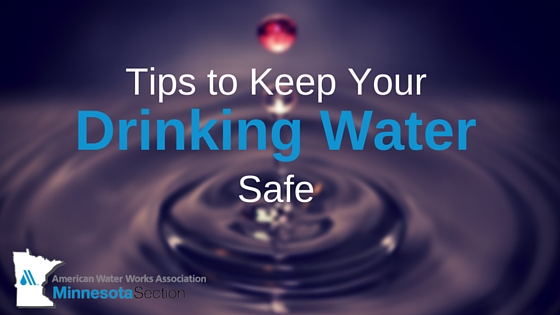Tips to Keep Your Drinking Water Safe

National Drinking Water Week will take place May 1st – May 7th. The American Water Works Association and its members have celebrated Drinking Water Week for more than 35 years.
Although the United States has one of the safest drinking water supplies in the world, the recent drinking water stories from Flint, Michigan have caused concern about the safety of their water. Though it remains very unlikely that Minnesota will see a similar problem, there are a few things you can do to ensure that your home drinking water is safe.
Education is the Key
Public water suppliers provide an annual water report called the Consumer Confidence Report. It has the most current testing data and outlines where your tap water comes from and if it is in compliance with EPA regulations. If you have questions, contact your water supplier. They are the best resource to help educate you on what you can do to ensure your tap water is safe.
Protecting Yourself from Lead
If you live in an older home, or your plumbing is out of date, there may be some risk of consuming small amounts of lead. “If you have a lead pipe in front of your house, if you were in my family, I would tell you to never, ever drink that water without filtering it,” says Marc Edwards, Virginia Tech civil and environmental engineer.
There are filtering systems on the market that tackle your entire house, but experts say your best defense takes place at the sink. Water filtered through a whole-house filtration system still needs to travel through pipes (possibly lead pipes) to reach your faucet. This is why it is best to invest in a filtration system at your kitchen sink. You don’t need to worry about showering in water. “There’s no harm; it doesn’t go in through your skin,” Edwards says.
 Private Wells
Private Wells
Public water sources are regulated and tested often, but private wells are the responsibility of the homeowner. If you get your drinking water from a private well, you should:
● Test your water frequently - at least once a year. Be sure to use a state certified laboratory. You may want to test more often if someone in your household is pregnant or nursing, someone becomes ill, you notice a difference in taste or smell, or you replace any part of your well system.
● Make sure to maintain your well and the related equipment. Well installers will service your equipment to ensure it is operating properly.
● Become educated on the aquifer and any well-head protection efforts that are implemented to ensure it remains a safe supplier of your water.
Purifying Your Water
What happens if you are alerted that your home tap water isn’t safe? Well, (pun intended) there are a few steps you can take to make absolutely sure it is safe to drink. Passing water through a muslin cloth or a home treatment device will help remove most impurities, but can still leave you vulnerable to bacteria and viruses. The best way to remove all impurities is to boil it - bring the water to a rolling boil, and continue for 1-2 minutes.
Containers Make a Difference
With so many water containers on the market today, don’t store your water in recycled containers from your home, like old milk jugs or juice containers - sugars and milk proteins settle at the bottom of these bottles and can cause bacterial growth. Start with a clean, NEW container to ensure the cleanest water.
Thanks to the billions of dollars invested in water systems across the country, water contamination in the United States is, thankfully, a very rare occurrence. Recent news stories have caused concern, but there is little reason to fear a problem in your tap water. To keep your mind at ease, follow the above tips and you will no doubt have the safest drinking water possible.
Happy Drinking Water Week from Minnesota AWWA.

No comments:
Post a Comment